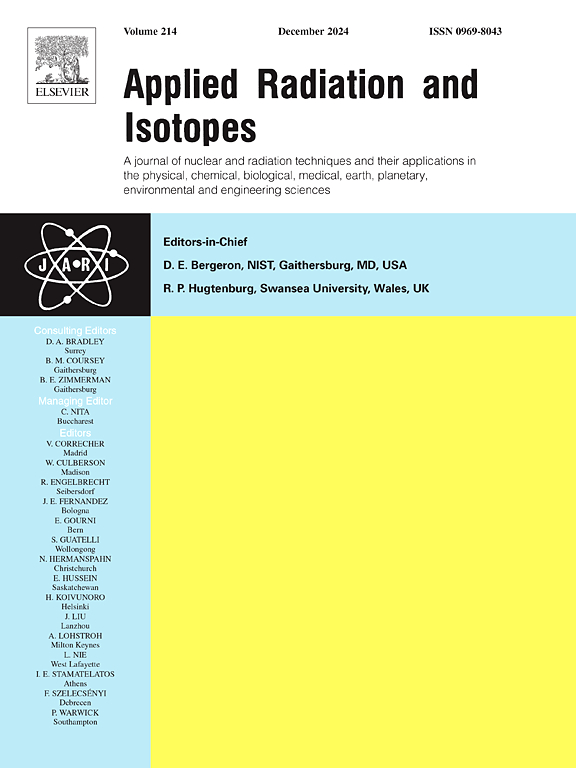Beam emittance measurement of low energy H− ion beam via solenoid scan method on the injector of AB-BNCT
IF 1.6
3区 工程技术
Q3 CHEMISTRY, INORGANIC & NUCLEAR
引用次数: 0
Abstract
Accelerator-based boron neutron capture therapy (BNCT) systems utilizing diverse accelerator technologies and neutron generation methodologies have shown promise for cancer treatment. The Korea Institute of Radiological & Medical Sciences (KIRAMS) is developing a K- BNCT project with an electrostatic accelerator to produce neutrons through nuclear reactions for BNCT. A prototype 500 keV KIRAMS electrostatic tandem (KEST-500) proton accelerator and an injector test stand (ITS) have been set up to evaluate beam parameters, with a focus on measuring beam emittance while considering space charge effects. The ITS component consists of a 30 keV negative hydrogen ion (H−) source, a solenoid magnet, and a beam profile monitor (BPrM). The main purpose of the ITS is to obtain a full understadnding of the high-current H− ion beams. Transfer matrix techniques are used to determine beam emittance at the solenoid entrance, while beam tracking simulations incorporating space charge effects provide a comprehensive analysis of beam transport. Results show the influence of beam current and energy on space charge impact and beam quality, highlighting the importance of considering space charge effects in accelerator systems.
用电磁扫描法测量AB-BNCT注入器上低能氢离子束的束发射度
基于加速器的硼中子捕获治疗(BNCT)系统利用多种加速器技术和中子生成方法,在癌症治疗中显示出前景。韩国放射学研究所;医学科学(KIRAMS)正在开发一个K- BNCT项目,利用静电加速器通过核反应为BNCT产生中子。建立了500 keV KIRAMS静电串联质子加速器(KEST-500)原型机和注入试验台(ITS)来评估束流参数,重点测量束流发射度,同时考虑空间电荷效应。ITS组件由一个30kev的负氢离子(H−)源、一个电磁磁铁和一个波束剖面监视器(BPrM)组成。ITS的主要目的是获得对大电流氢离子束的全面了解。传输矩阵技术用于确定螺线管入口的光束发射度,而结合空间电荷效应的光束跟踪模拟提供了对光束传输的全面分析。结果显示了束流电流和束流能量对空间电荷冲击和束流质量的影响,突出了在加速器系统中考虑空间电荷效应的重要性。
本文章由计算机程序翻译,如有差异,请以英文原文为准。
求助全文
约1分钟内获得全文
求助全文
来源期刊

Applied Radiation and Isotopes
工程技术-核科学技术
CiteScore
3.00
自引率
12.50%
发文量
406
审稿时长
13.5 months
期刊介绍:
Applied Radiation and Isotopes provides a high quality medium for the publication of substantial, original and scientific and technological papers on the development and peaceful application of nuclear, radiation and radionuclide techniques in chemistry, physics, biochemistry, biology, medicine, security, engineering and in the earth, planetary and environmental sciences, all including dosimetry. Nuclear techniques are defined in the broadest sense and both experimental and theoretical papers are welcome. They include the development and use of α- and β-particles, X-rays and γ-rays, neutrons and other nuclear particles and radiations from all sources, including radionuclides, synchrotron sources, cyclotrons and reactors and from the natural environment.
The journal aims to publish papers with significance to an international audience, containing substantial novelty and scientific impact. The Editors reserve the rights to reject, with or without external review, papers that do not meet these criteria.
Papers dealing with radiation processing, i.e., where radiation is used to bring about a biological, chemical or physical change in a material, should be directed to our sister journal Radiation Physics and Chemistry.
 求助内容:
求助内容: 应助结果提醒方式:
应助结果提醒方式:


